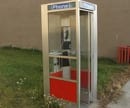The other day I drove by a crane picking an old rooftop HVAC unit from a building’s roof. This kind of stuff always catches my eye, but this one was different — I installed that old unit back in 1986. I remember rigging it into place like it was this morning; giving the crane operator the hand signal to “spool out” and set the unit on its curb. We used hand signals because business owners thought “walky-talkies” were too expensive to give to mechanics.
That’s right, back then we were called “air conditioning mechanics” and a technician was someone who worked on electronics. The name “technician” didn’t start gracing our ranks until 1990 or so; still a few years off.
I remember after the job was finished I grabbed a quick burger and drove around town looking for a working pay phone. We had to check in with our service manager after every job and the only way to make the call was to use the customer’s phone or find a pay phone; cell phones weren’t commonplace until around 1997.
Eighties Vans: No Radios or Air Conditioning
A typical 1986 weekday began by firing-up the service van and letting it warm up for 10 or 15 minutes before heading to the shop. You had to, because the trucks had carburetors with chokes back then, and you weren’t going anywhere until the engine warmed up.
If it was summer, you drove with the windows down because company owners didn’t spend the extra money on A/C for service trucks. They also didn’t believe in radios; your tunes came from a boom box set between the seats.
Once at the office you received your list of calls for the day, and if it was Monday, the on-call mechanic would hand the duty pager off to the next guy on rotation. Pagers were expensive, so only the mechanic on duty carried one. The only people carrying pagers back then were A/C mechanics and doctors.
Old School Tools, Like 30-Pound Wrenches
Arriving at the job, you grabbed your leather tool pouch (nylon tool bags didn’t exist yet), refrigeration gauges, and your electrical meters. The meters were usually made by Amprobe or Simpson — they were analog, made of Bakelite, and were heavy, bulky and very expensive. Digital meters were just hitting the market at that time, but they were expensive and the red LED displays couldn’t be read in direct sunlight.
 Whatever you were working on, you could be pretty certain the control panel would be filled with relays, contactors, motorized sequencers, and about twenty miles of wire. If you were unlucky, and the unit was new, it may have a crude, first generation, electronic control board.
Whatever you were working on, you could be pretty certain the control panel would be filled with relays, contactors, motorized sequencers, and about twenty miles of wire. If you were unlucky, and the unit was new, it may have a crude, first generation, electronic control board.
Those first generation control boards had no fault indicator lights or digital displays to help you find the problem; nothing but a forest of resistors, transistors, and capacitors staring you in the face. Troubleshooting guides for these modern wonders of technology were almost nonexistent at the time. It didn’t matter, we worked our way through it because we had to. Remember, we couldn’t call “tech support” on our cell phones like you guys can today; we were on our own.
The standard tools for locating refrigerant leaks were soap bubble solution and a halide torch. If you were into cutting-edge tools, a GE electronic refrigerant leak detector was available, but it was bulky, heavy, powered by an extension cord, and expensive.
If you were working on threaded pipe, you were using cast iron pipe wrenches that weighed about 30 pounds each. Aluminum wrenches were just entering the market but they cost more than you made in a week. The up side of cast iron wrenches was you got your weight lifting in without paying for a gym membership.
Once we found the leak, we didn’t recover the refrigerant, we vented it. Back then it was legal to vent, and there was no such thing as a “refrigerant recovery machine”. Besides, a thirty pound jug of “22” was only about thirty dollars. A year later we heard talk of something called the “Montreal Protocol” but we had no idea what exactly it was, or how drastically it was going to affect our industry.
 Simpler Times
Simpler Times
What’s the biggest difference between then and now? The stress. We may have been lugging around heavy tools and driving trucks without air conditioning, but our mental stress levels were nowhere near what technicians are exposed to today.
We would get out our list of calls for the day and that was it. The dispatcher wasn’t calling to ask if you could hurry it up because you have ten more calls ahead of you. You had peace and quiet, you could give your full attention to what you were doing.
There’s something to be said for the old days.


Great piece! I love the part about the boombox between the seats too. Are you still out in the field or gladly done with that part?
I spend three quarters of my time “riding a desk” and the rest getting my hands dirty. I have to say, there is a lot more satisfaction in getting your hands dirty.
Patrick
Feels like I’m behind a computer screen more and more myself. I do remember those days of sticking the boombox between the seats, though. Miss ’em! Thanks again for the great article.
This is great Patrick. I was born in 86′ and hear stories like this from my Dad and guys that have been with our company since 1983. Very very cool!
I’m a second generation HVAC technician (mechanic) also.
My father started in the trade in the late forty’s, and used to tell me how easy I had it; the “panel trucks” had “three on the tree” transmissions and no power steering….and they didn’t have threaded rod, they had to thread the ends of round stock by hand…
At least he didn’t tell me he had to walk to work up hill, both ways!
But hey, listen to those guys, as the saying goes; “they’ve forgotten more than we’ll ever know”, and its true!
Patrick
I am a little reluctant to go along with calling the time when fridge could be vented with wild abandon a better time….
And I have to chuckle a little that I am getting links from ACCA full of Reagan-hugging and excoriation of regulations, when the main reason our office has more than a passing extent to do with ACCA recently is the requirement to use their methods imposed by…. The U.S. Green Building Council’s LEED for Homes certifications.
Cool Article. I enjoy a small amount of this crazy new age technology, but wish I could go back to 1986 (1970’s to be exact)…more simple times, kids actually playing outside, people actually having human to human conversations as opposed to silly Twittering and robot-like conversations – #wherepeopletalklikethis @socialemdia RT @twitter. Oh the good “old” days!